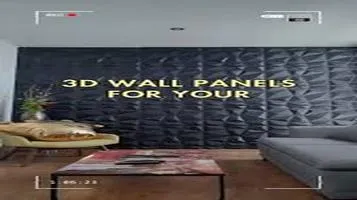Review of 3D Wall Panels: Transforming Spaces with Dimension and Style
3D wall panels are an innovative interior design element that adds texture and dimension to any space. Made from a variety of materials such as wood, plant fiber, PVC, or gypsum, these panels are crafted to create a dynamic, sculptural effect on walls. They are available in a wide range of patterns, from geometric shapes to organic motifs, allowing for versatile design possibilities that can suit modern, contemporary, or traditional aesthetics. Easy to install, 3D wall panels can be painted or left in their natural finish to complement existing decor. Beyond their visual appeal, they can also enhance acoustics and insulation in a room. Ideal for both residential and commercial spaces, 3D wall panels are a stylish way to transform ordinary walls into captivating focal points.

In the ever-evolving world of interior design, 3D wall panels have emerged as a revolutionary element that can dramatically transform a space. These panels, characterized by their textured and embossed surfaces, offer a dynamic alternative to conventional wall treatments like paint and wallpaper. They serve not only as a decorative feature but also as an architectural element that adds depth, texture, and a sense of modernity to any room. Having explored various brands and installations, I can confidently say that 3D wall panels are a worthy investment for those looking to elevate their interiors.
First and foremost, one of the most striking advantages of 3D wall panels is their aesthetic appeal. Unlike flat surfaces, these panels create visual interest through shadows and highlights that change with lighting conditions. This play of light and shadow can make a room feel more alive and engaging. Whether you prefer geometric patterns, organic shapes, or intricate designs, there is a 3D wall panel to suit every taste. The variety of designs available in the market ensures that you can find something that matches your personal style and the overall theme of your space.
One of the most commendable aspects of 3D wall panels is their versatility. They can be used in a variety of settings—residential, commercial, and even industrial spaces. In homes, they can serve as a stunning feature wall in living rooms, bedrooms, or dining areas. In commercial spaces, they can be used to create an inviting ambiance in lobbies, restaurants, and retail stores. Because of their ability to transform the mood of a space, they are increasingly being used in hospitality and entertainment sectors as well.
Another significant benefit of 3D wall panels is their ability to hide imperfections. Walls that are uneven, cracked, or blemished can be covered up effectively with these panels, eliminating the need for extensive prep work. This makes them an excellent choice for renovation projects where time and budget constraints might be a concern. Furthermore, many 3D wall panels are designed to be lightweight and easy to install, often featuring interlocking systems or adhesive backs that make the installation process straightforward and quick. This ease of installation translates to reduced labor costs and a faster turnaround time for projects.
When it comes to materials, 3D wall panels come in a wide range of options, each with its own set of characteristics. Common materials include MDF (Medium Density Fiberboard), PVC (Polyvinyl Chloride), plant fibers, and even metals. MDF panels are known for their durability and can be painted to match any color scheme. PVC panels are lightweight, waterproof, and easy to clean, making them ideal for bathrooms and kitchens. Panels made from plant fibers, such as bamboo or sugarcane, offer an eco-friendly option and add a natural touch to the decor. Metal panels, though less common, can provide a sleek, industrial look that is perfect for modern and contemporary spaces.
However, it is essential to consider a few drawbacks. One potential downside is the cost. High-quality 3D wall panels can be expensive, especially when covering large areas. While the initial investment might be steep, the long-term benefits in terms of durability and aesthetic appeal often justify the cost. Additionally, some materials, like MDF, might require additional finishing or sealing to ensure longevity, adding to the overall expense.
Maintenance is another factor to consider. While materials like PVC are low-maintenance, others might require regular cleaning and upkeep to retain their appearance. For instance, panels made from natural fibers might need to be dusted frequently and kept away from moisture to prevent damage. Therefore, it is crucial to choose a material that aligns with your lifestyle and the specific requirements of the space.
In conclusion, 3D wall panels are a fantastic way to add dimension, style, and sophistication to any interior. Their aesthetic versatility, ease of installation, and ability to mask imperfections make them a popular choice among homeowners and designers alike. While the initial cost and maintenance requirements might be considerations, the transformative impact they have on a space makes them worth the investment. Whether you are looking to create a focal point in a room or completely overhaul your interior design, 3D wall panels offer a unique and compelling solution that is sure to leave a lasting impression.






